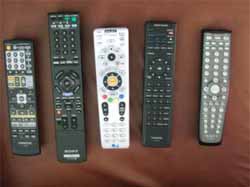Guide to Programmable and Universal Remote Controls
Click here enlarge. So close.
Congratulations. You came here to Projector Reviews, read the reviews and purchased the right projector for your home theater needs. You’ve hooked up your surround sound receiver, DVD player, HD cable or satellite box and maybe even an HD DVD or Blu-ray disk player. Now, you’re ready to enjoy a movie or sporting event on the big screen in the comfort of your own home. Your home theater is complete . . . or is it?
 Click Image to Enlarge
Click Image to EnlargeYou look down on the seat next to you and see five (or more) remotes lined up and no matter what you’re going to watch, you’re going to use at least three of them. Your better half complains about the pile of remotes laying around, as well as the fact that it’s impossible to figure out which ones are needed to watch TV. Editor's note: I'd like to take a moment to introduce, and welcome Mike Rollett, in his first contribution to www.ProjectorReviews.com. I've known Mike for about four years. He is local to us. He's visited my old company, and has been by Projector Reviews (my house) a number of times, to check out the projectors I'm reviewing. Mike is "another one of us" who really loves home theater equipment and performance. He is a retired engineer and lawyer, and Mike owns Surf Audio, a local home theater installation company (and he programs remotes). Mike is also a Senior Editor for Home Theater Spot. Mike is "into" programmable remotes, and he has written a number of articles, and currently is also a beta tester for Universal Remote Control. Who better to do an excellent introductory piece on the remote choices out there today. I fully intend to have him program mine, as soon as my room is finished (this summer). Mike also reviews other equipment, so you may be seeing additional reviews on our site, including Blu-ray DVD players, written by Mike. Welcome aboard! -art OK, back to Mike! Okay, you decide you need a universal remote. You try the so-called universal remote that came with your receiver (or some other component), but it doesn’t have the codes for all of your equipment and is even more confusing for your spouse. So, you hop on the internet to search for universal remote options and you are bombarded with a plethora of choices. Which one is right for you? Read on. Editor's note - Clarification: The two most popular terms for these remotes are: Programmable remotes, and universal remotes. In this article Mike often uses "universal remotes" to talk about some or all of the remotes, but he also talks about individual products made by one of the leading remote manufacturers: Universal Remote Control.
IR or RF Remote Controls?
Click here enlarge. So close.
Nearly all home theater components are either controlled solely via IR (infrared) or have the ability to be controlled via IR. IR is commonly used for remotes because it is cheap, easy to implement and doesn’t require government licensing. Its downside is that it requires a clear line-of-sight between the remote and the component. For some home theaters, this is not a problem, but with many, components are in a dedicated cabinet, closet or even in another room (i.e.: a single cable box feeding multiple rooms). Also, with a front projector, its location is often above and/or behind the seating position, making it difficult to control via IR. Bouncing the signal off the projection screen usually works, but can be a problem in a large room or when using a drop-down screen.
 Click Image to Enlarge
Click Image to EnlargeTo get around the inherent limitations of IR, many universal remote manufacturers are using RF (radio frequency) transmitters in their remotes. These RF transmitters communicate via RF (which can have a range over 100’ through walls/floors) to a base station. The remote essentially converts the IR signal to RF and the RF base station converts the signal back to IR. The base station then typically controls equipment via wired IR emitters, which are stuck on the face of each component over its IR receiving eye via a peel-and-stick pad on the emitter. In many cases, the individual IR emitters can be separately assigned, enabling independent control of identical components. Most RF base stations also have a front blaster, so they can be placed in front of a rack of components, then blast IR to all of them. As this usually requires some room in front of the components to place the base station, it doesn’t work well in cabinets or other tight locations. Below is a typical RF base station, the MRF-350 from Universal Remote Control. If you have a component that can only be controlled via RF (like some of the older Bose Lifestyle systems), then getting an IR/RF universal remote will not control it, as the remote only uses RF to communicate to its own base station.
PC-Programmable Remote Controls
If you want a universal remote that will not only take care of you current needs, you should definitely consider getting one where the programming can be done in your PC and downloaded to the remote. Why is this important? Well, in addition to the ease of setting up your components by simply looking up the make and model in a database, you also get access to commands that may not be on your original remotes. Such commands are typically known as discrete commands.
Examples of discrete commands are separate On/Off commands and individual input commands. Most components come with remotes that have a simple “Power” button on them. Push the button once and the component turns on, push it again and the component turns off. This is fine for single remote use, but when you’re programming a universal remote, one of its best features is the ability to program macros where a single button push is all that’s needed to turn on everything to “Watch a DVD”. This is where having discrete On/Off commands comes into play. For example, you’d typically like to have buttons programmed with macros so that a single push turns on everything and switches the appropriate inputs to watch a DVD or watch cable/satellite. Since both macros require that the projector or TV be turned on, using the typical “Power” command in such a macro would turn the component of it were already on. Those of you who own projectors know that the last thing you want to do is accidentally turn off a projector, since you need to wait for the bulb to cool before you can safely turn it back on.
Similarly, without discrete inputs, you can only cycle through inputs by repeatedly pushing an Input button. This doesn’t work well with macros, as it would depend on which input the component (usually a TV) was on for the correct number of Input button presses to be applied.
What’s all this got to do with PC-programmability? Well, most PC-programmable remotes have these discrete commands available in their databases, which in many cases are regularly updated. Even if they don’t, there’s usually the ability to get them from the manufacturer in some format that can be used by the software.
Additionally, having a PC-programmable remote often means that you can save your remote configurations, easily try different ones and share remote files with others. While using a universal remote programming solution can seem daunting at first, you’ll find that it ultimately makes your programming easier, as well as future proof.
Button or Touchscreen Remote Control?
Universal remotes are usually either a combination of hard-labeled and text or graphics labeled buttons, or touchscreen buttons. Most touchscreen remotes have hard buttons for the most oft-used functions, like Volume and Channel Up/Down, but the majority of the buttons are typically in the form of graphics on a touchscreen. Basically, which one you choose is a matter of personal preference. Some like the freedom of making any size button they wish simply by changing the size of the graphic, as well as the “cool” factor of having animated graphics and the multiple page changes that are possible on such remotes. On the downside, touchscreen remotes are usually more expensive and fragile than their hard button counterparts.
Button remote fanciers will argue that you always have to look at a touchscreen remote to use it, where with a button remote, you can find the most used buttons by touch. Also, using a button remote is one-handed operation, while touchscreens usually require two hands.
Recently, trying to cater to both preferences, more manufacturers have been creating remotes that combine the graphics of touchscreens with a hard button remote.
What Does A Good Universal Remote Control Cost?
I’ve saved this category for last for a good reason. There are universal remotes that meet the requirements listed above in many price ranges, from under $100 to over $1000. You really need to determine what type of universal remote you want and/or need before you can decide which one to buy in the price range you can afford. I’ve talked to people that have $50,000+ home theaters that balk at spending $200 on a universal remote, while others buy a $600 remote to control their TV, cable box and DVD player. Remember that no matter how few or how many components you have in your system, a universal remote is the only “component” that will be used every single time.
With that in mind, let me run down some of the more popular universal remotes in their respective price categories. If you don’t see your personal favorite in there, please keep in mind that this is not meant to be a complete listing of available universal remotes. Also, I’ve tried to limit the list to those remotes that can be purchased and programmed by an end user. There are a number of remotes in the higher price ranges that are not available at retail, either in a store or on the internet, only from custom installers that will also program the remotes for you. RTI and Crestron are a few examples of such remotes.
Click for Descriptions and Photos of Popular Remote Controls from Well Known Manufacturers



